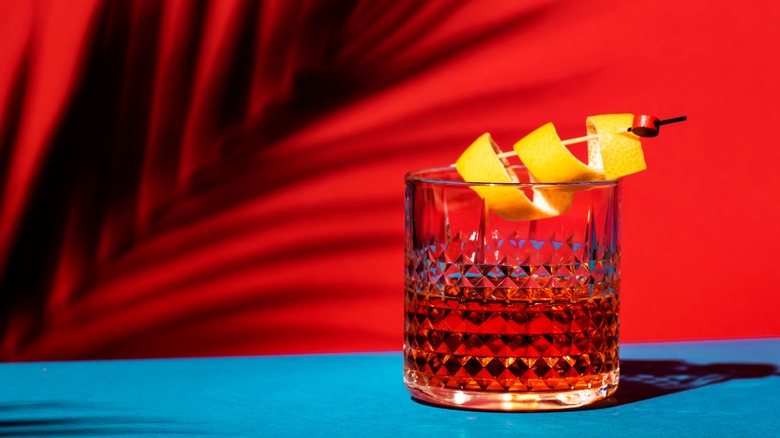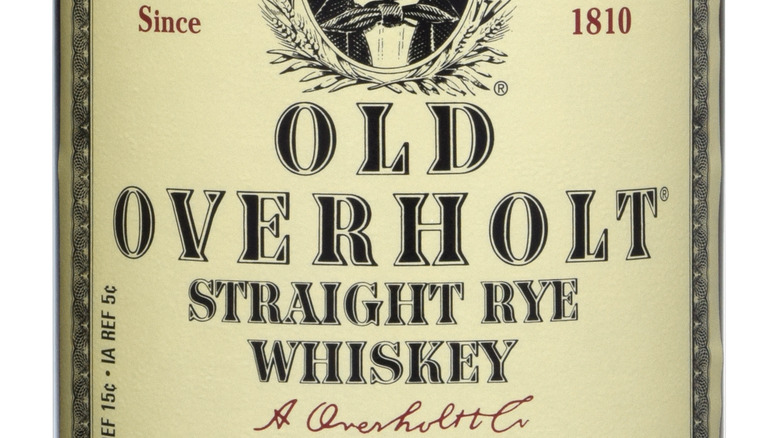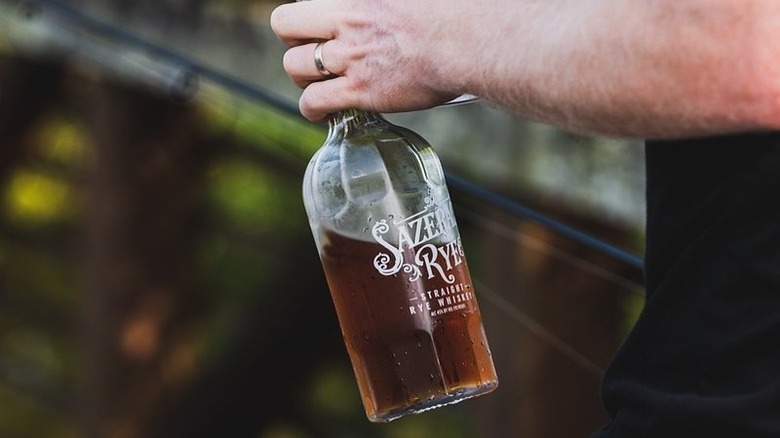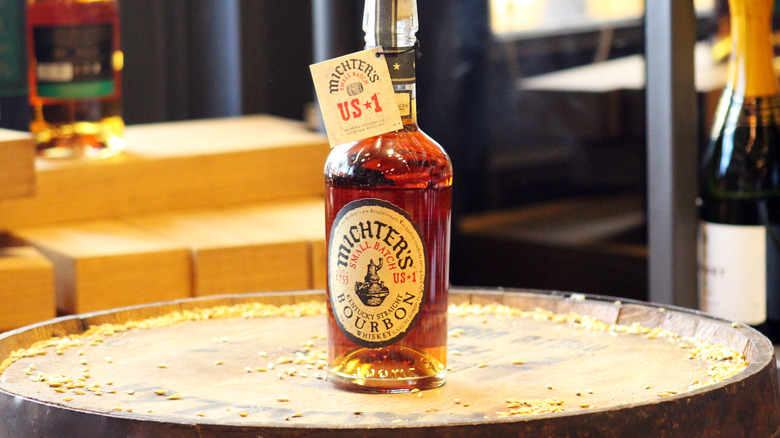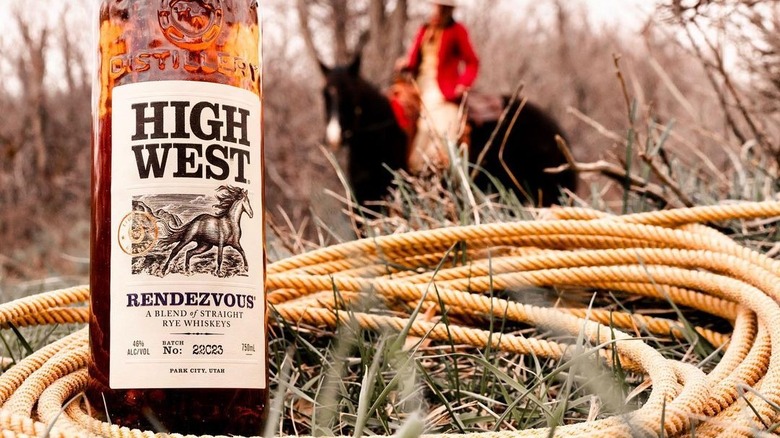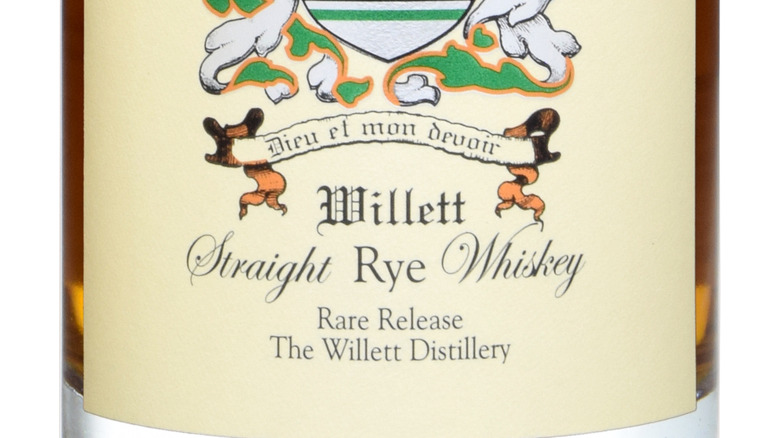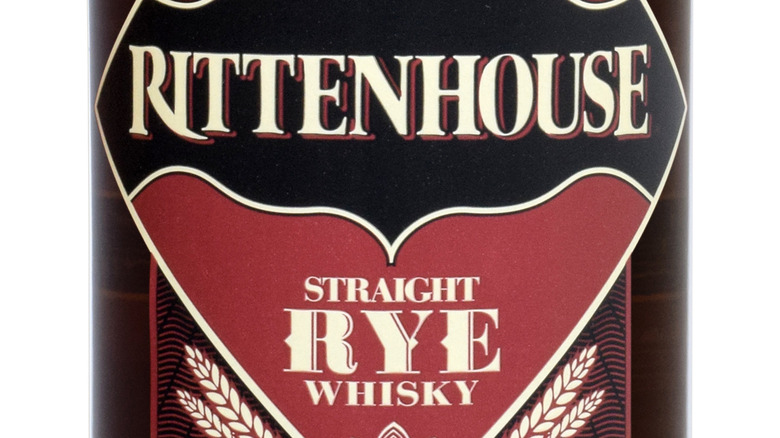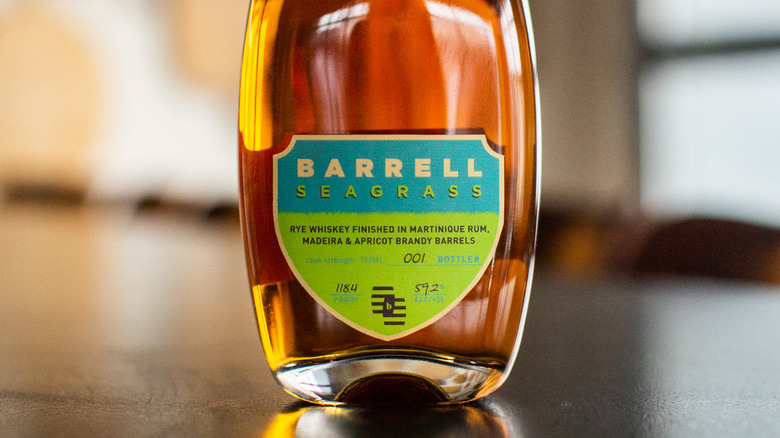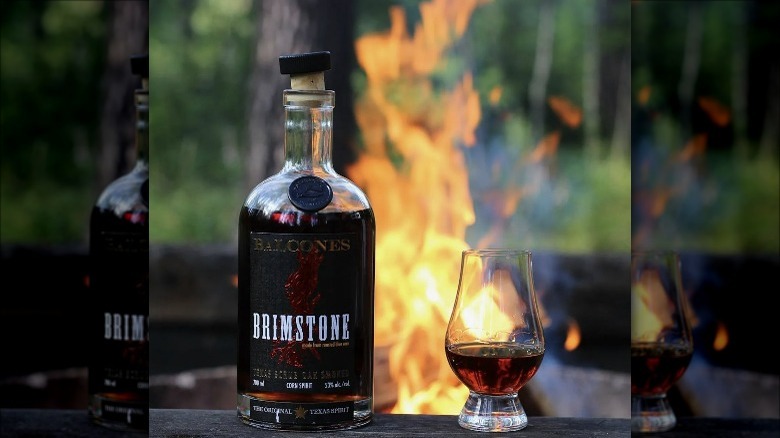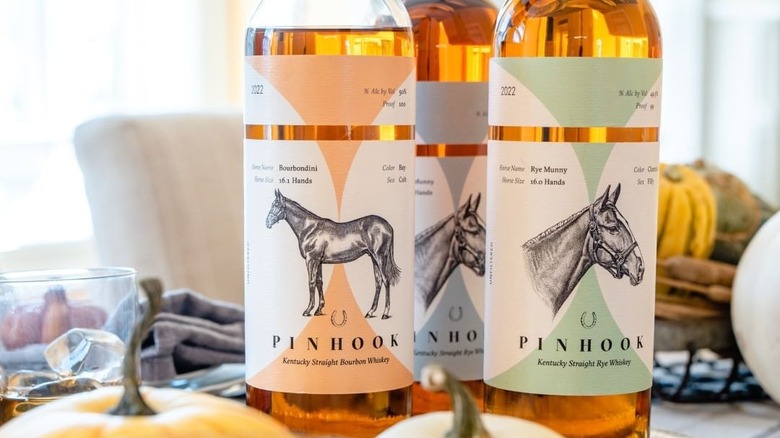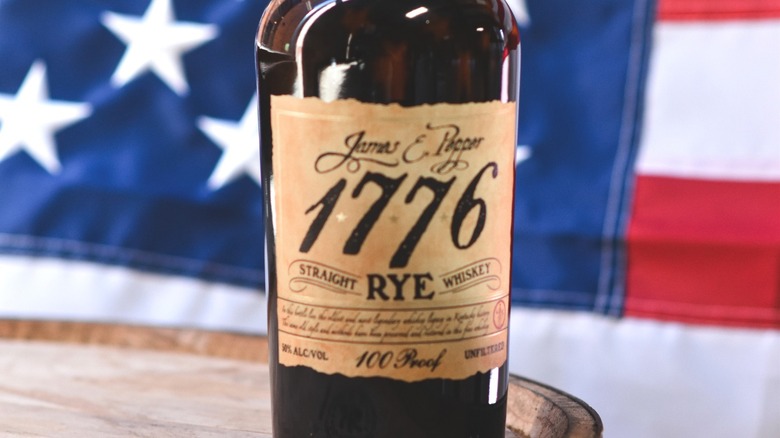10 Best Whiskeys For A Sazerac
The Sazerac cocktail is indelibly intertwined with the city of New Orleans. According to NewOrleans.com, a Creole apothecary named Antoine Peychaud (you know — of Peychaud's bitters?) invented the cocktail back in 1838. Its name was a shortening of Sazerac-de-Forge et fils, a French brandy that served as the base liquor in Peychaud's earliest iterations of the drink. We've heard and read many histories of the Sazerac cocktail in our drinking days, and like most cocktail histories, this one is rife with contradictions and muddy timelines depending on which bartender's spinning the tale. What's known for certain, however, is that rye whiskey supplanted French brandy at some point, cementing itself as the key player in the classic Sazerac cocktail recipe we all know and love today: rye, absinthe, sugar, and bitters (preferably Peychaud's).
To celebrate the delicious Sazerac, we've compiled a list of the whiskeys we find best suited to the drink. While tradition — and most modern recipes — call for rye as the base liquor, there's always wiggle room for improvisation or experimentation if you've got a shifting palate or a mixed bag on your home bar. The Sazerac evolved over time, and we think it should continue evolving as new drinkers discover its delights.
Old Overholt Straight Rye Whiskey
Spend any amount of time with bartenders and you'll quickly learn that most of them have pretty strong opinions on exactly what ingredients a certain cocktail should contain and how it should be made. Ask around about the Sazerac, and you'll be met with some very strong opinions about Old Overholt. Many mixologists we've come across tout Old Overholt rye as the only acceptable whiskey choice when you're making a Sazerac. While we won't endorse any one whiskey as the whiskey for a Sazerac, we do recommend Old Overholt as a stellar choice and a very solid addition to any home bar.
According to its website, Old Overholt Rye is the oldest American rye still available today, and has been produced without interruption since the distillery's inception in 1810. (Old Overholt is oddly quiet on the pesky topic of what was going on during Prohibition ... hmm.) It's very accessible from both price and availability standpoints, and its flavor profile has enough spice and vanilla to offset the more fruit-forward notes. We would categorize this one in the medium-bodied weight class there are plenty of beefier ryes out there. This is a solid multi-purpose rye that performs really well in a Sazerac or any other rye-based cocktail you might dream up.
Sazerac Rye
Amid the storied history of the Sazerac cocktail lies the famous Sazerac Coffee House, a 19th century New Orleans drinking establishment. The Coffee House expanded over the years to a second location, the Sazerac Bar (via East Texas Bourbon Society), and eventually those two evolved into the Sazerac Company, which has continued to grow over the last century. It now includes such famous labels as Pappy Van Winkle and Buffalo Trace and is responsible for producing — surprise, surprise — Sazerac Rye.
It should come as no surprise that this eponymous rye ranks among the best whiskeys for a Sazerac cocktail. And it's definitely the other contender for mixology purists when arguing about the "one true rye" for a Sazerac. While Old Overholt vs. Sazerac is a battle anybody would count themselves lucky to judge, we don't think there's any reason to fight. Where Old Overholt is fruit-driven and soft (relatively), Sazerac is bold with warming spices, vanilla, and a touch of peppermint. This is a heftier, burlier rye that beefs up the cocktail. Both whiskeys have earned their place on your home bar, so we say ... por que no los dos?
Michter's US*1 Kentucky Straight Bourbon
Michter's is a brand that puts out consistently solid stuff, and it finds a spot in our Sazerac heart for both its rye and its bourbon. Michter's US*1 Kentucky Straight Rye is a well-balanced, spicy rye with just enough vanilla and butterscotch to offset some of its woodier characteristics. It'll play well off the herbal notes in your absinthe and provide the cocktail with a strong, robust backbone.
Similarly, Michter's US 1 Kentucky Straight Bourbon is also a fantastic choice for your next Sazerac. Though purists will tell you the Sazerac must be made with rye, don't listen to 'em. Once upon a time, it just had to be made with cognac — and look where we are now! So if you prefer a softer, slightly sweeter base spirit in your cocktail, don't be afraid to jump on the bourbon train. Michter's flagship bourbon is everything we love about the spirit: It's flavorful without being aggressive, bold without being obnoxious. It introduces a fruitier flavor profile to your drink without sacrificing the oakiness of the rye, and is a great sipping bourbon to boot.
High West Rendezvous Rye
High West is a popular brand that puts out a bunch of different whiskeys and whiskey-based bottles, including single malt, bourbon, rye, and pre-batched cocktails. To complicate things further, it offers several different types of rye. But chief among them for us is the Rendezvous Rye, both for its availability relative to the distellery's rarer bottlings as well as its suitability to the cocktail.
Rendezvous is a seasonal release and boasts a high rye mash bill which makes it a more rye-y rye than your normal, um ... rye. If you're looking to get adventurous with your next cocktail and you're lucky enough to happen upon a bottle of High West Campfire, give that a go as well. It's a blend of scotch, bourbon, and rye whiskies which makes for a spirit unlike almost any other you might chance upon. Expect an explosion of smoke, spice, fruit, and wood with this one. It'll dress up a Sazerac for sure, but you might need to raise the quantity of absinthe as well so it doesn't get lost amid the orchestra of flavor that Campfire has to offer.
Willett Family Estate 4-Year
There are those whiskey enthusiasts who would scoff at the idea of "wasting" a pricier bottle on a cocktail. In our opinion, however, Sazeracs are a perfect example where you should experiment with the nicer stuff if you've got the opportunity. After all, rye is the star of the show in this drink, and neither the bitters nor the sugar nor the absinthe is going to step on a well-made rye enough to mute its natural beauty.
Enter Willett Family Estate 4-Year Rye, a slightly higher proof (110) small batch rye whiskey that's worth every penny. Depending on where you're geographically located, it should run somewhere between $60-100, and that's money well spent for this gorgeously spicy bottle. You'll find a lot of whiskey reviews waxing poetic about how tasting notes of "baking spices" or "warming spices" predominate, and it's certainly true here. The dessert-like flavors are offset by a subtle fruitiness, and this stuff makes for a strong but beautifully integrated Sazerac that'll have you mixing up a second (or third) batch in no time.
Rittenhouse Rye
Rittenhouse Rye is a bottled in bond whiskey that plays a utilitarian role in filling that oft-neglected hole on your bar cart. Where's the everyday drinkin' rye? Where is the inexpensive but high-quality stuff you can sip on its own, shoot alongside a beer, or use in a delicious fall cocktail? Does there exist such a spirit? There sure does, and it's called Rittenhouse.
A bottle of this rye usually doesn't break the $30 mark, yet remains a perennially reliable go-to for a tasty rye Manhattan, rye Old Fashioneds, or — you guessed it — Sazeracs. It has a slightly darker, more concentrated flavor profile than some of the lighter ryes we've chosen, with notes of chocolate and dark spices taking a front seat. And because it's got a higher ABV, it has no problem standing up to the intensity of absinthe or getting lost amid the sugar and bitters of the cocktail. Don't overthink this: Try Rittenhouse Rye for your next Sazerac and you won't be disappointed.
Barrell Seagrass
Barrell Seagrass is a very unusual rye, and promises to make a unique Sazerac. It's made from a blend of American and Canadian whiskeys which are aged in rum, Madeira, and apricot brandy barrels. When we tasted it, we were surprised and delighted by how accurately the Seagrass name communicates the whiskey's actual flavor. Whatever magic is happening inside those barrels translates beautifully to the finished product: Seagrass is a symphony of fruity, salty, almost green tasting rye whiskey that's unlike anything in recent memory.
Use this stuff for a Sazerac and you've practically invented a new cocktail. The tropical notes of the whiskey play well with the absinthe, and the whole thing is leveled out by the balancing agent that is Peychaud's bitters. Barrell's also got a ton of other options, including bourbon, blended whiskeys, and even rum. So if you like what you find in Seagrass, feel free to give one of their other bottles a shot. Especially close to our hearts is the Armida bourbon, which is aged in brandy, rum, and amaro casks. Though the flavor profile is obviously different from the Seagrass rye, the spirit of the thing is the same: an unusual, delightfully different bourbon that jazzes up any cocktail you choose.
Balcones Brimstone
The name might give it away, but in case you didn't get the memo: Balcones Brimstone is a hot, fiery, smoked Texas whisky. So why does it rank among our top whiskeys for a Sazerac? Well, precisely because it's so different. Wandering off the beaten path is exciting sometimes, and nothing will get your blood up quite like this intense spirit.
According to Balcones, the whisky is smoked using a "secret process" which results in a bold, slightly fruity, mostly smoky whisky. In a Sazerac, it bounces off the brightness of absinthe and pushes the bounds of what a classic cocktail can become. Given that the Sazerac is already such a booze-forward drink, leaning into a stronger flavor profile doesn't muck things up the way it might in something softer or more delicate. Instead, Balcones Brimstone announces itself proudly in the drink, declaring itself the foundation for a new style of Sazerac.
Pinhook
Pinhook is another twofer choice that offers both rye and bourbon options to build your next Sazerac. Each year, the brand releases new vintages of whiskey that vary in their mash bills and flavor profiles. We've been fans of this stuff for several years now, and they've yet to disappoint. The brand's flagship ryes are typically energetic and lifted (as opposed to something darker and more subdued, like Rittenhouse), and they feature a beautiful balance of spice and fruit.
The bourbons, on the other hand, are rich and full-bodied, with dessert notes of molasses, caramel, and vanilla. Given the differences between bourbon and rye, the bourbons are naturally a touch sweeter than the ryes, which is to be expected, and offer a sweet spin on a Sazerac that never strays into cloying or syrupy territory.
Pinhook hits that sweet spot both in terms of price and availability: It's not so expensive that it'll break the bank, and it's not so common that everybody's got it. You'll spend a touch more for this small batch bourbon or rye, but it's quality stuff that keeps on giving.
James E. Pepper 1776 Straight Rye
The Pepper family holds the distinction of being the oldest brand of whiskey produced in Kentucky (via the James E. Pepper website). It was founded by Colonel James E. Pepper in 1780, and he affectionally referred to the whiskey as "Old 1776" — a name which was revived in 2012 and won several subsequent awards.
The mash bill here is very rye heavy, at 95%, which means this stuff is a purist's dream. Expect spice, earth, and a touch of vanilla on the palate, with an undercurrent of something decidedly bright. (The distillery describes it as mint or eucalyptus, though we don't know if we'd go that far.)
This is a beautiful rye to build a Sazerac with, as its flavor profile complements the absinthe wash and integrates Peychaud's bitters nicely.It's also both affordable and accessible, and the brand produces a bourbon as well if you're in the mood for something a touch sweeter. Enjoy!
